Ah, the great indoors. We often overlook the places we spend the majority of our time in (over 4 hours a week in the bathroom alone!) when it comes to our favorite plants. Sure we have the flowerbeds, planter boxes, and backyard gardens all sorted out – but what to do when we want to bring some green indoors?
Indoor plants are easy to maintain and can be placed in any room of your home. From ferns to ficus, houseplants can add color, beauty and texture to your space and offer air cleaning health benefits.
The key is to know which varieties work best indoors, what level of care is required for them, and understanding what you can realistically expect from indoor plants (we’re looking at you orchids).
Keep reading to learn about the best houseplants, indoor plants care and maintenance tips, the right location for potted plants in your home, and how to take care of an indoor plant that is dying from the Texas Certified Nursery Professionals at Calloway’s and Cornelius Nursery.
How to Pick the Best Houseplants
Picking the right houseplant is easy- but it does require a little forethought if you want to get the most out of your houseplant. First, consider the light and air flow in your space as these are important factors that will help you decide what house plants are ideal for you.
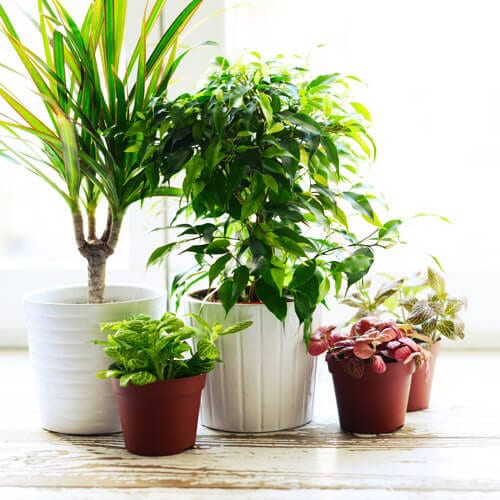
If your home doesn’t offer a lot of natural light, do not stress. Areas with low light can still be used for indoor plants. The ZZ Plant (aka the Zanzibar Gem, the ZuZu, or for those among us who took Latin in school: Zamioculcas zamiifolia) is a great option because it only needs to absorb a minimum amount of light and can tolerate dry soil– meaning if you forget to water it for a period of time, it won’t break your heart one morning in the form of a brown husk of neglect. Plus, ZZ Plant is resistant to plant disease, insects and mites. Additional low light indoor plants include Peace Lily, English Ivy, Boston Fern, Cast Iron Plant, Palms, Pothos, Dracaena and Orchids.
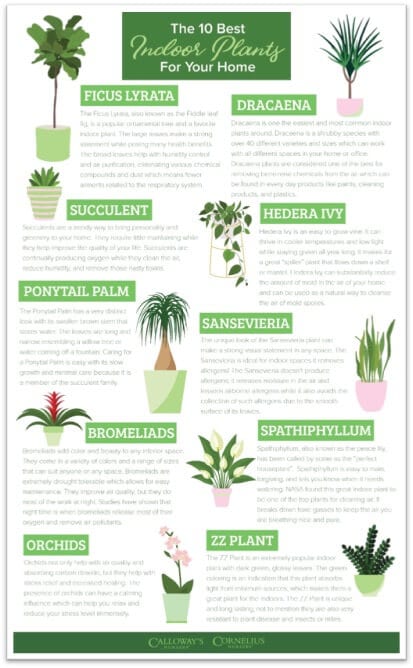
Indoor Plants for Your Bedroom
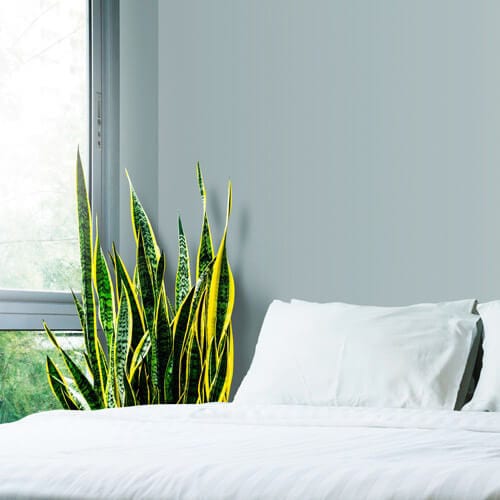
Another important factor when considering the best houseplants for your space is the location or room you want to put your plants in.
Different rooms will naturally have different light and airflow patterns, plus there’s something to be said for what you will be doing in that room. Take your bedroom, for example – the room where you want to relax, get some good sleep and wake up refreshed. Is there a plant for that? Several, actually, but on the best are plants from the Bromeliad family which release the majority of their oxygen – while working to remove pollutants – at night so they are a great option to have in your bedroom while you sleep. Plus, due to their variety, there’s a bromeliad to go with virtually any bedroom decor.
Another choice indoor plant that makes the most sense for your bedroom is the Sansevieria (aka Devil’s Tongue, Snake Plant, or Bow String Hemp), which lowers airborne allergen levels while it releases moisture into the air.
Indoor Plants for Your Kitchen
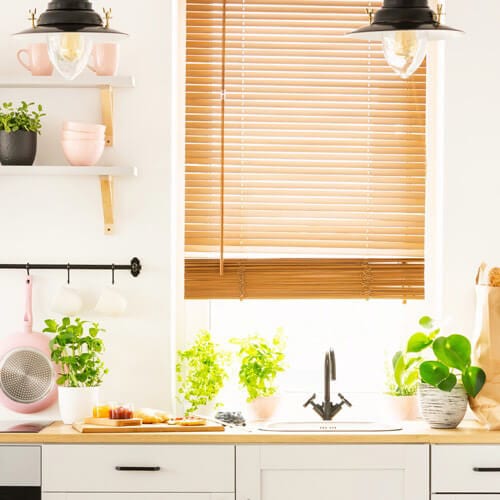
When you think about your kitchen from a plant’s point of view, you can guess that fluctuating temperatures, varying light levels (from sun-drenched to overheard lighting), and all manner of smells and other airborne “extras” will play a major role in deciding which plants work best in the heart of your home.
Plants that help with moisture control are the best types to have in your kitchen. Ficus Lyrate, also known as Fiddle-Leaf Fig, controls humidity and purifies the air, naturally cleaning your kitchen of chemical compounds and dust. Additionally, Hedera Ivy can substantially reduce the amount of mold in the air.
Dracaena is one of the best plant choices to remove harmful pollutants, like benzene chemicals commonly found in cleaning products, plastics and paint, from the air. Because of their air cleaning properties, Dracaena is an ideal indoor plant for people with asthma.
Live in an apartment or other small space? Succulents and Orchids are compact houseplants that offer many of the same benefits of other indoor plants that work in your bedroom or kitchen. Pair these plants with a colorful pot or container garden to add instant style to your space!
Just understand that while those orchids look great when you buy them, they do go through dormant phases where they will not flower unless you pay particular attention to nighttime temperature levels.
If you haven’t figured it out by now, indoor plants can be some of the best all-natural air cleaners – significantly boosting the quality of the air you breathe in the one place you spend the most of your life: your home.
The Easiest Indoor Plants to Care For

While most houseplants are low maintenance, there are a few varieties that are especially easy to care for. . If you fear you may have a shade of thumb other than green, here are some plants even the most inexperienced indoor plant-lover can enjoy–Bromeliads, Cacti, Succulents, Airplants, Ponytail Palm, Hedera Ivy, Maidenhair Fern and more are all relatively manageable – even for beginner gardeners.
If you’re too afraid to flex your green thumb just yet, start with Succulents, Cacti or Airplants because they only require minimal watering or misting.
You can forget about them for days without having to suffer the depression that is a plant that died “on your watch” (we’ve all been there).
Houseplant Care Tips
Just like outdoor plants, indoor plants need care and maintenance with water, light and proper nourishment to grow, survive and thrive. However, keep in mind that indoor plants do not like standing in water.
One of the most popular ways in which indoor plants suffer and die is due to over-watering. Fear not, we’ll cover watering in the next section.

Create the proper environment for a houseplant by providing a sufficient draining system with the right type of soil and container. Calloway’s and Cornelius Nursery carry many varieties of soil, specially formulated to help specific types of plants, including Calloway’s Premium Potting Soil, made with a combination of professional composted pine bark, professional grade peat moss, composted rice hulls, the finest grade of coconut coir, shale, 6 month controlled release fertilizer used by professional growers, wetting agent, and hydrogel crystals that expand and contract based on soil moisture. For our plants that need less moisture, Black Gold® Cactus Mix, which contains a combination of horticulture grade pumice, or cinders, earthworm castings, compost, bark, and forest humus to provide the ideal soil structure and drainage for all types of cacti, bromeliads and succulents, and Black Gold® Orchid Mix.
Let’s talk drainage; every indoor plant should be potted with drain holes at the bottom of the pot and a saucer or water tray to allow for proper drainage, again to avoid overwatering and to compensate for the lack of heat and sun that will allow your indoor plants to retain more moisture than their outdoor counterparts.
Regularly prune your houseplants to promote continued growth of leaves. Remove discolored or leggy leaves or stems as you see them appear to ensure the plant uses its energy to promote new, healthy growth.
When you buy an indoor potted plant, keep the plant tag handy as it has all the information you need on water and light requirements to care for that specific plant.
Watering Rules for Inside Plants
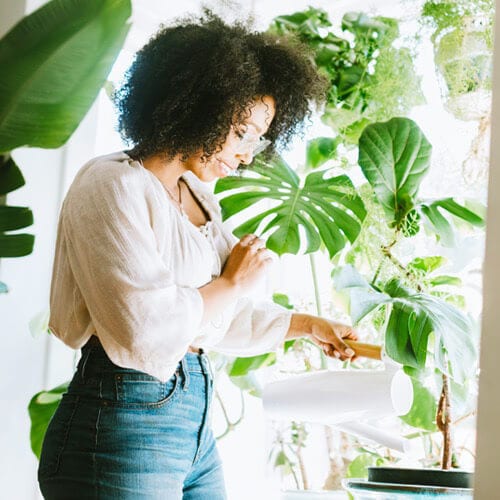
As a rule of thumb, follow these instructions below to water your indoor plants.
- Cacti and succulents need periods of dry soil before watering again.
- Plants with thick, lush and green leaves need more frequent watering.
- Plants with waxy leaves need less frequent watering.
Light Requirements for Indoor Plants
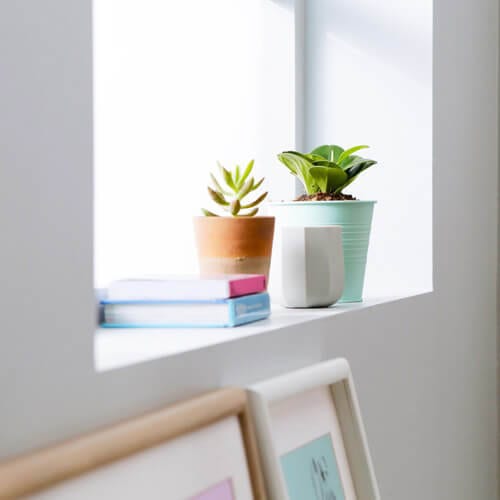
All plants need light, but at varying levels. Rotate plants in windows or any space to ensure the leaves get equal light on all sides for healthy, happy growth.
This will also help them to grow more evenly – if you don’t rotate them, you’ll learn what phototropism (growth of an organism in response to light stimulus) is, and how it’ll make your plant lean (and grow) solely in the direction of the most sunlight it receives. Your gardening professional can advise you whether you need medium indirect sunlight, bright indirect light, or a full sunlight.
The best indoor plants for low light (less than three hours a day) include one of the most popular houseplants, Philodendron, as well as Pothos, Palms, Boston Ferns and more.
Indoor plants that require medium light (at least four hours a day) include Ponytail Palms and Spathiphyllums.
The best houseplants for high light areas (more than six hours a day) include Crotons, Ficus plants and more.
It’s also important to consider if your plant needs indirect light, filtered light or direct bright light. Place the plant in a room in your home that will provide the right type of light. Not sure? Consult one of our Calloway’s or Cornelius Texas Certified Nursery Professionals and keep your plant tags as a reference.
Food & Nourishment for Indoor Plants
Special plant foods are formulated to provide extra nourishment to plants, which is vital to develop strong roots and grow into thriving plants. Calloway’s Amazing Gardens is a great option for your indoor potted plants. Calloway’s Amazing Gardens is a multi-purpose formula that immediately releases plant food that provides an instant impact to a variety of plants. It’s safe to use on your vegetables, bedding plants, and houseplants. When used as directed, this fast-acting formula helps your garden produce maximum growth.
The Best Temperature for Houseplants

Indoor temperature and humidity levels in your house can affect a plant’s ability to survive and thrive. Keep your thermostat above 55 degrees Fahrenheit and avoid placing plants near cold drafts to keep plants happy and healthy.
How to Take Care of an Indoor Plant that is Dying
Water can truly impact the health and lifespan of your houseplants. It is possible to both water too much and not water enough. Signs of improper watering include slow leaf growth, brown and dried leaf edges, or curled, yellow lower leaves on a plant. Get yourself a water meter at any Calloway’s or Cornelius Nursery location to aid your plants’ growth. Water meters can measure the exact amount of water that your house plant needs, making it easy for you to know how frequently to water.
Indoor plants can add beauty, quality of life, temperature and humidity control, and even a sense of accomplishment to your home. When you’re ready to pick the indoor plants you want for your home, stop by your nearest Calloway’s or Cornelius Nursery location to speak with one our Texas Certified Nursery Professionals who can assist you with selecting the right products and provide expert knowledge to properly care for your houseplants.